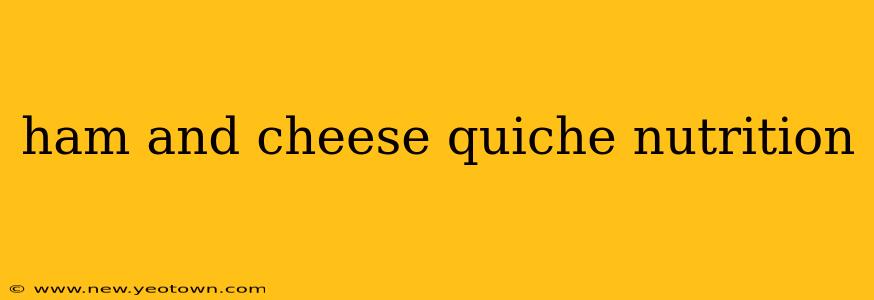The aroma of a perfectly baked ham and cheese quiche—a symphony of savory ham, melted cheese, and creamy custard—is enough to make anyone's mouth water. But beyond its delightful taste, what's the nutritional profile of this classic dish? Let's delve into the delicious details and uncover the nutritional facts behind this comforting favorite. This isn't just a recipe; it's a nutritional journey!
What are the macronutrients in a ham and cheese quiche?
A typical serving of ham and cheese quiche (approximately one slice from a 9-inch quiche) will vary depending on the recipe and ingredients used. However, we can explore the general macronutrient breakdown. Imagine this: you're biting into a slice, the flaky crust giving way to the rich, creamy filling. That experience is fueled by a balance of macronutrients. You'll find a moderate amount of protein, primarily from the eggs and ham. The cheese contributes fat, which adds richness and flavor. Carbohydrates are mainly derived from the crust, though the amount varies greatly depending on whether you're using a pastry crust or a gluten-free alternative.
How many calories are in a slice of ham and cheese quiche?
The calorie count per slice can range significantly, from around 250 to 400 calories. Several factors influence this number. A richer crust, a higher proportion of cheese, and the type of ham used all contribute to the overall calorie content. Think of it like this: a quiche made with a buttery, flaky crust will naturally be higher in calories than one with a whole-wheat or gluten-free crust. Similarly, using a full-fat cheese will significantly increase the calorie count compared to using a lower-fat variety. Portion size also matters!
Is ham and cheese quiche healthy?
The healthiness of a ham and cheese quiche depends heavily on the ingredients and preparation methods. A quiche made with whole-wheat crust, lean ham, reduced-fat cheese, and plenty of vegetables can be a surprisingly nutritious choice. The eggs provide a good source of protein and essential nutrients. However, a quiche loaded with high-fat cheese, processed ham, and a rich pastry crust is less healthy due to its high saturated fat and sodium content. It's all about balance and mindful ingredient selection. The key is to look for recipes that emphasize whole foods and lean proteins.
What are the benefits of eating ham and cheese quiche?
When prepared thoughtfully, a ham and cheese quiche can offer several nutritional advantages. Eggs are an excellent source of protein, crucial for building and repairing tissues. They also provide essential vitamins and minerals like choline, vitamin D, and vitamin B12. The cheese, depending on the type, contributes calcium and protein. Vegetables, if incorporated generously into the filling, add valuable vitamins, minerals, and fiber. It’s a complete meal in a single slice—provided the ingredients are balanced and nutritious.
Is ham and cheese quiche good for weight loss?
Because of the potential for high fat and calories, ham and cheese quiche isn't generally considered ideal for weight loss. However, modifying the recipe to use lean ham, low-fat cheese, and a whole-wheat or gluten-free crust can significantly reduce the calorie and fat content, making it a more weight-loss-friendly option. Moderation is key. Enjoying a small portion as part of a balanced diet won't derail your weight loss goals.
Can I make a healthier ham and cheese quiche?
Absolutely! Making a healthier quiche is achievable with some smart swaps. Use a whole-wheat or gluten-free crust to reduce refined carbs. Opt for lean ham to lower the saturated fat content. Choose lower-fat cheeses like part-skim mozzarella or reduced-fat cheddar. And most importantly, boost the vegetable content! Adding spinach, mushrooms, onions, or peppers not only adds flavor and texture but also increases the nutrient density of the quiche. Consider using a smaller crust to reduce the overall carbohydrate intake.
In conclusion, a ham and cheese quiche can be a delicious and satisfying meal, but its nutritional profile hinges on the ingredients. By making conscious choices and focusing on healthier ingredients, you can enjoy this classic dish without compromising your health goals. Remember, mindful cooking and careful ingredient selection are the keys to enjoying your favorite foods while maintaining a balanced and nutritious diet.

